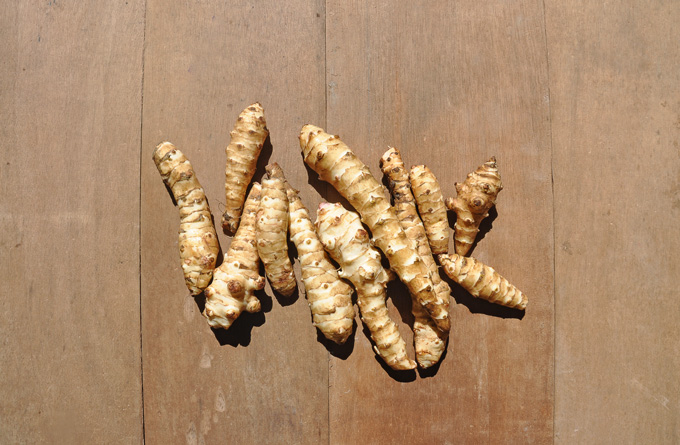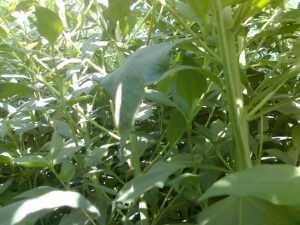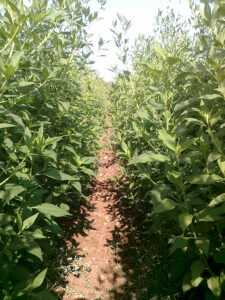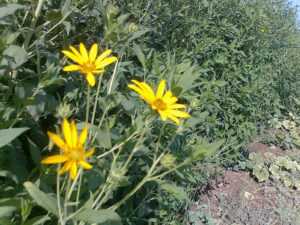Mysterious Secrets of the Underworld
As tradition dictates, on Open Day I took our young visitors for an outing into the field. Usually I assign the kids detective tasks, with their mission being to discover which vegetable is growing in a particular bed. Sometimes it’s easy, like with green beans or peppers. Other times, the more experienced children or their knowledgeable parents figure it out. But as usual, when we reached one specific bed, none of them could solve the mystery of the secret vegetable buried below.
Indeed, it was the incredible sunroot, aka Helianthus tuberosus or, better yet, its very confusing nickname: Jerusalem Artichoke. Many of you have been receiving it in your boxes over the past few weeks. But first, a clarification: the sunroot looks like ginger, but it certainly is not ginger!
We waited for them over six months, till the bushes dried up and wilted. Only then could we chop them down and begin pulling out the secret treasures covered by earth – delectable, satiating bulbs that will upgrade every soup, quiche, antipasti or salad. And you don’t need a lot — they can be used as a spice. Here in Chubeza, they are one of our younger products. We’ve only been growing them for around for three years, ever since we tried a bite and fell in love with its taste. But enough about us, let’s get around to discussing the star of this week’s Newsletter, the Sunroot.
this great photo from Gal’s blog, Ptitim:
The title “sunroot” is actually an accurate description, for the Jerusalem artichoke is in fact a species of sunflower which develops an edible root bulb. The origins of this delectable bulb are in the North American East Coast from Georgia to Nova Scotia, where it has been both growing wild and cultivated in Native American vegetable gardens for years on end. Here the Jerusalem artichoke fully enjoys the American sunshine and rich, fertile earth, yielding farmers and gleaners its rich roots that abound with energy and sweetness.
The Europeans who came to visit and stayed to conquer tasted it and loved it. The first to describe the bulb was French explorer Samuel de Champlain, who noticed it in a Cape Cod vegetable garden in 1602. He sent some to France, from where it meandered to England, Germany and Italy. The Italians termed it girasole, Italian for “sunflower.” Somehow the pronunciation was distorted to “Jerusalem,” and it stuck. The “artichoke” part came from the fact that it somewhat resembles the artichoke in taste. In America, it’s commonly known as a “sunchoke.”
Like any sunflower, it adores the sun and grows during the summer. For Chubeza, this is the third summer we’ve watched its growth. I say “watch,” because from the moment we placed the bulbs in the earth until we plunged the pitchfork in to remove them, we really did not have much to do (aside from occasional weeding and watering). We were rather amazed at the beautiful strength of its growth, at its ability to joyfully grow wild and dare the weeds to even think of coming close. In our field, the Jerusalem artichoke is free from pests (moles and rats are their natural nemesis), which is why we could just step aside and simply watch it grow. Patiently.
Here it is going wild, blooming, growing: The Jerusalem artichoke in Chubeza:
And yes, we required much patience. The plant took its sweet time for at least seven months, growing, wilting and clandestinely swelling up its unique roots. In the middle of October when the foliage had dried up, we inserted the pitchfork to examine the situation, only to discover that we needed more patience. So we waited a bit longer, regularly sampling some to gobble up for lunch. Now, we are finally beginning to pull out all these yummy, distinctive bulbs. Welcome, gals!
Though it grows underground like the potato (even if it is more stubborn and recalcitrant than the latter) and has a similar caloric value, the Jerusalem artichoke is low in carbs. Instead of starch, it contains inulin, a fruit sucrose carbohydrate, soluble in water (which is how it stores its energy in the root bulb). Inulin aids in lowering blood sugar levels, making it recommended for diabetics (contrary to potatoes!). Inulin feeds the friendly microbes in the intestines and reduces the threat of a variety of diseases. On the other hand, it may cause gas, so if you’re first beginning to eat Jerusalem artichokes, start slowly to get the body accustomed. These bulbs are an excellent source of thiamine, iron, niacin, Vitamin B3 and potassium. Chinese medicine classifies the Jerusalem artichoke as a warming vegetable which strengthens the digestive system. A great winter vegetable!
If you wish, you may peel it. If you don’t like peeling the knobby bulbs, here are some tips from Phylis Glazer:
The Jerusalem artichoke turns black quickly after being peeled, so it is recommended to place it in a bowl filled with water and two tablespoons of lemon juice, or simply drop into milk and cook away. Soaking in water causes the vegetable to lose the B vitamins, which are soluble. Thus it’s best to peel them and give the artichokes a quick soak, or soak from time to time in a water and lemon juice solution while peeling. You can also scrub them well and cook them unpeeled (a young Jerusalem artichoke can be eaten with peeling) and then use the soaking water for soup or other type of dish. If the bumps make it hard to peel, steam the roots for several minutes to remove the peeling with ease.
Check our Recipe Corner for a variety of suggestions for cooking and serving the amazing sunroot, but feel free to add it to other familiar and favorite recipes in your own creative way. It really enhances the flavor in almost every dish. Bon appetite!
Wishing you a good and healthy week,
Alon, Bat Ami, Dror, Maya and the entire Chubeza team
WHAT’S IN THIS WEEK’S BOXES?
Monday: Slice of pumpkin, celery, lettuce/arugula, tomatoes, daikon/turnips, beans/lubia/Jerusalem artichoke, dill/coriander, cucumbers, carrots, kale/spinach, fennel/kohlrabi
Large box, in addition: Beets, leeks, sweet potatoes
Wednesday: Cilantro/parsley/dill, Swiss chard/kale/New Zealand spinach, cucumbers, lettuce/arugula, tomatoes, celery, slice of pumpkin, daikon/radish/turnip, carrots, fennel/kohlrabi, small boxes only: eggplants/corn.
Large box, in addition: Green and yellow beans/yard long beans/fresh black eye peas (lubia)/Jerusalem artichoke, sweet potatoes, beets, leeks
And there’s more! You can add to your basket a wide, delectable range of additional products from fine small producers: flour, fruits, honey, dates, almonds, garbanzo beans, crackers, probiotic foods, dried fruits and leathers, olive oil, bakery products, pomegranate juice and goat dairy too! You can learn more about each producer on the Chubeza website. On our order system there’s a detailed listing of the products and their cost, you can make an order online now!
JERUSALEM ARTICHOKE RECIPE CORNER:
Tal sent me this vegan recipe of Chef Yossi Shitrit from the “Kitchen Market” Restaurant:
JERUSALEM ARTICHOKE SOUP
3 cups Jerusalem artichokes (around 1 – 1 ½ kilo), peeled and sliced into cubes
½ cup sliced leeks (only the white part of one medium-sized leek)
4 whole garlic cloves
1 spring of lemon thyme (or regular)
Water
2 T chopped lemongrass (or grated rind of half a lemon)
1 container of coconut milk
2 T. chopped ginger
3 T olive oil
1 T coconut oil
Salt and freshly-ground black pepper
Preparation:
- In a wide pot, melt the coconut oil. Add the leeks and steam lightly while stirring 2-3 minutes, till leeks are transparent.
- Add the garlic cloves, the lemongrass and ginger. Sauté for around two minutes. Add the Jerusalem artichoke and enough water to cover.
- Bring to a boil. Lower heat to a light boil and cook for around 30 minutes, or till artichokes are completely soft.
- Add the coconut milk and season with salt and pepper. Blend soup well together with liquid in food processor or hand-blender till smooth. If desired, press soup through fine-meshed sieve till completely smooth. Return to pot until served.




